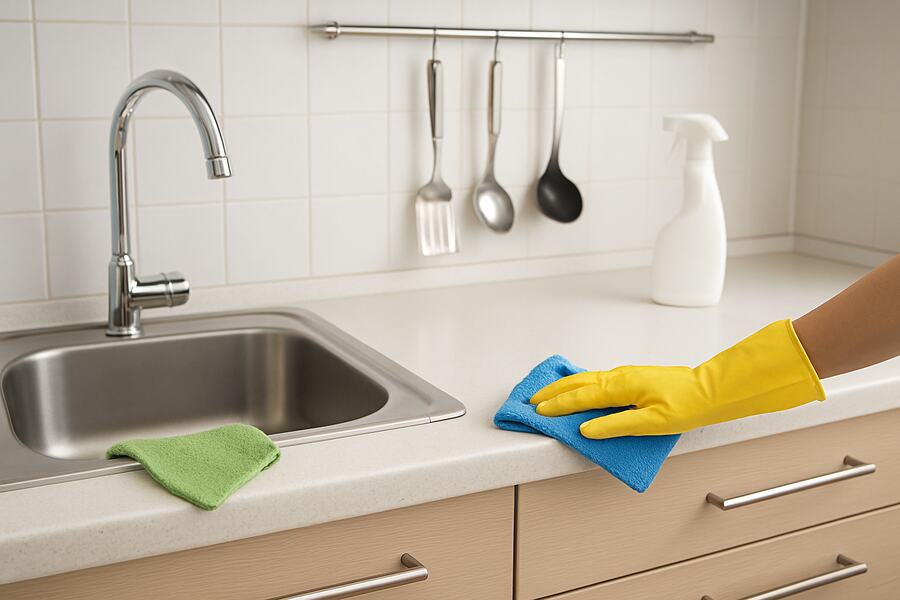Are your kitchen fittings in the same condition as when you first fitted them? appear shiny and clean? Otherwise, you are not the only one. Kitchen fittings, be it the sink, taps, cabinet handles, or the built-in appliances, are the maestros of your kitchen. They are prone to stains, dullness, and even wear as they undergo a lot of use, grease splashes, and moisture. The good news? Kitchen fittings can stay as good as new for many years as long as they are regularly cleaned and as long as the appropriate methods of maintenance are employed.
Your kitchen is not only a cooking place but typically the centre of your home as well. When sinks, counters, wall cabinets, and other frameworks that make up a kitchen are well maintained, they not only promote hygiene, but the entire aesthetic appearance, particularly in the cooking area as well will be uplifted by this factor. In this blog, we will be walking you through simple tips that you can follow and clean and maintain your kitchen fittings to ensure they stay shiny, working and durable.
1. Find out what Kitchen Fittings are
One should establish the kind of kitchen fittings before rolling into the cleaning process, as per Bond Cleaning Perth. Are they stainless steel/ chrome/ brass /matte black? Do you have wooden handles or a ceramic fitting? All materials have varying degrees of cleaning necessity in order to avoid damage. Example: Harsh abrasives can cause too much scrubbing on stainless steel, and acid cleaners can cause some tarnishing to the brass. This will make you aware of your fittings to make the safest cleaning options.
2. Daily Wipe-Down to Avoid Buildup
Among the easiest of fittings in your kitchen is to clean them daily, thus maintaining them. Clean with a soft, warm, soapy water and microfiber cloth any tap, handle, and surfaces after cooking. This type of quick regime prevents the accumulation of grease and dirt, and in the event of a massive cleaning up in the future, would not present much challenge.
Pro Tip: Take care to wipe with the grain when polishing stainless steel kitchen fittings, or you can end up with streaks.
3. Long Lasting Shine with Gentle Cleaners
Gentle is the mode when washing kitchen fittings. Avoid the use of bleach or chemical cleaning agents that are too hard because they can either burn off protective layers or leave a stain in some other place. Better still, use soft dishwashing soap or white vinegar (where there is limescale) or a pH-neutral cleaner. These ensure your fittings are clean, and they do not wear them out over time.
4. Attack Limescale on Sinks and Taps
Taps and sinks are kitchen fittings that have a tendency to attract limescale, more so in regions with hard water. To get it out, dab it with a white vinegar-soaked cloth, wrap the affected spot and leave it on there for 15 and 20 minutes. And, clean briskly with a soft brush. The technique removes limescale in a non-scratching way. For more details on water quality and hard water effects, check the official guide by the Australian Government – Water Quality.
5. Preserve Wood and Painted Fittings
Wooden handles used in your kitchen fittings and painted hardware in the cabinets must be kept dry since they can bend or flake off. A wet but not too wet cloth is to be used to clean it, and it should be dried instantly. After every three months or so, give them a polish that is safe for wood to keep them moisturised and lush looking.
6. A Professional Polish
After cleaning your kitchen fittings, you should put a polish to create an extra glamour. Work on a product made specifically to fit your fitting type- stainless steel polish, chrome spray, or wood natural oils. This will not only make them gleam, but it will also expose them to a protective covering against fingerprints and watermarks.
Just like polishing fittings, refreshing other parts of your home can also make a big difference. For example, you can read our guide on Best Ways to Make Your Curtains Clean and Fresh to uplift the look of your living space.
7. Do not miss the Secret places
Others just clean what they are able to see in their kitchen fittings, but dirt and grease might be lurking in the corners, the hinges and behind the handles. Brush in such areas using a soft brush or by using cotton swabs. The move will keep your fittings clean in all corners and crannies to avoid long-term wear and tear.
8. Treat Grease on Cabinet Hardware
Cabinet handles and knobs, particularly, around the cooking area, may get stubbornly attached to grease. Take 2-3 parts baking soda: water proportion, prepare and apply to the fittings and leave few minutes before wiping. This natural degreaser dissolves oil residues into it without damaging the material.
9. Create a Maintenance Schedule
In order to maintain your fittings in the kitchen in the best shape, establish a maintenance schedule.
- Daily: Clean the surfaces with a wipe after using.
- Weekly: Clean thoroughly taps, handles and sink areas.
- Monthly: Polish metal surfaces and check screw fasteners are not loose or damaged.
This timeline makes your fittings work throughout the year and be presentable.
10. Examine signs of wear and tear
The fittings in the kitchen are not there only to be beautiful objects; they are items used to prepare food. In the course of time, screws can become loose, finishing can fade, or the seals can wear out. It is important to check on these because once you get over to expensive replacements one day, then it is hard to mitigate this fact.
Conclusion
The same attention should be given to your kitchen fittings as it is with your countertops or any given appliances. Also take note of these cleaning and general maintenance tips, and as well as maintaining your new fittings’ appearance, you are well on the road to guaranteeing long-term usage.
Note: frequent maintenance is the trick to constant shine and performance. Therefore, when the time comes to clean up the kitchen, next time pay your fittings some added attention, it is those poor folks who do all the work to make your kitchen run smoothly.


